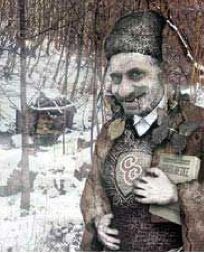
Last month, we posted a story
about the Serbian village of Zarožje, when town officials issued a
warning about a vampire that may have been disturbed. To get the lowdown
on such superstitions, National Geographic News talked to Mark Collins
Jenkins, author of the book
Vampire Forensics, and forensic archeologist and anthropologist Matteo Borrini.
Is it crazy that the town council issued a public health warning?
MCJ:
Historically speaking, it's not that crazy. In past centuries,
outbreaks of vampire hysteria, especially in Central and Eastern Europe,
often coincided with outbreaks of tuberculosis and deadly plagues.
Peasants had no other way of explaining why everyone was dropping dead
but by blaming it on witches and vampires or other supernatural
creatures. In 19th-century New England, tuberculosis wasted entire
families, one after another. Superstitious people believed that the
first to die was somehow feeding on his surviving family members.
(Related: "'Vampire of Venice' Unmasked: Plague Victim & Witch?")
Why did people begin believing in vampires?
MB:
Especially between the 16th and 18th centuries, little was known about
what happens to the body after death. During plagues and epidemics, mass
graves were continually reopened to bury new dead. People sometimes
exhumed the bodies of the diseased to look for possible causes. Reports
about vampires describe exhumations weeks or months after death, during
the body's decay.
MCJ: Bodies weren't embalmed back then. They
rot, to be quite frank, in grossly different ways. If a bunch of people
in the village started dying in mysterious ways, they'd dig up the first
one to die, see that his corpse didn't look quite right, assume that
was blood flowing down those cheeks (it's called purge fluid in modern
forensics, a natural byproduct of decomposition, but it's not blood),
and generally burn the body. End of vampire.
Read the rest at
NatGeo .
 Last month, we posted a story
about the Serbian village of Zarožje, when town officials issued a
warning about a vampire that may have been disturbed. To get the lowdown
on such superstitions, National Geographic News talked to Mark Collins
Jenkins, author of the book Vampire Forensics, and forensic archeologist and anthropologist Matteo Borrini.
Last month, we posted a story
about the Serbian village of Zarožje, when town officials issued a
warning about a vampire that may have been disturbed. To get the lowdown
on such superstitions, National Geographic News talked to Mark Collins
Jenkins, author of the book Vampire Forensics, and forensic archeologist and anthropologist Matteo Borrini.
No comments:
Post a Comment